The death of Béla IV, known as the second founder of the State, 750 years ago, no matter how round the anniversary, did not cause too much attention in Hungary. Although it was possible to read short and long commemorations here and there about his struggles against the Mongols and his efforts to rebuild the country after the Tartar invasion in 1241-1242, none of the writings covered all that Budapest could owe him.
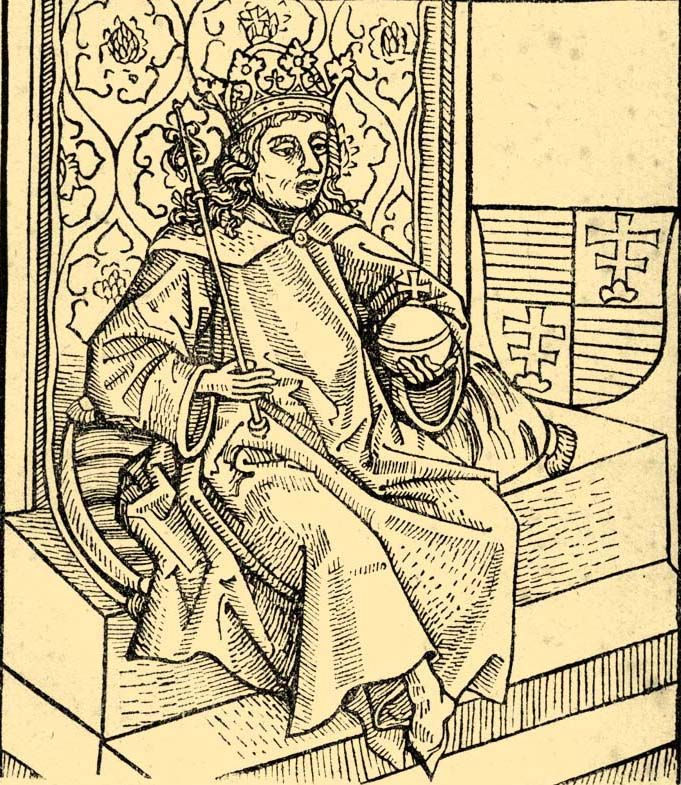
Representation of Béla IV in the Augsburg edition of the Thuróczi Chronicle (1488)
Although it is not an uninteresting fact that our king, who died on 3 May 1270, founded today's Buda. According to the famous archaeologist and historian László Zolnay, the construction of the Castle Hill started in 1243, shortly after the withdrawal of the Mongol armies. Béla surrounded the city with a wall to protect the Hungarian and German populations from Óbuda and Pest from the next attack, had its street structure designed, the plots parcelled out, and construction could begin.
The settlement, built in a few years, became a royal capital, and in later decades irrevocably gained the rank of capital. Medieval Buda was the centre of the country and the pearl of the Danube for centuries, legends were made about its beauty, and a series of chronicles and travelogues reported on its splendour.
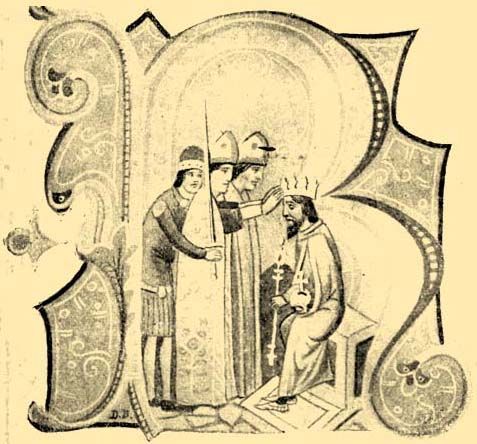
Béla IV in the Chronicon Pictum (1360)
Although in the centuries since then the city has been destroyed several times in various wars (1686, 1849, 1944-1945), the streets of Buda Castle still have countless memories of the years after its foundation. If anyone was to set out now to visit the sites to which Béla IV had something to do with, they could prepare for a long hike.
He built the Church of the Assumption on Szentháromság Square (even though it has been rebuilt several times since), which was first mentioned in written sources in 1247. In the years after the foundation, the Church of Mary Magdalene was also completed (which was demolished after 1945, today only its tower stands). The walls of the Dominican convent he founded (enclosed in the Hilton Hotel) can still be seen from the Fisherman's Bastion. There are also the ruins of the Franciscan monastery he founded under the Sándor Palace; sitting cabins that were made in his life can be found in several buildings, and the street front of several residential houses in Buda Castle preserves details to which Béla IV could look at just as we do when we walk among the ancient houses.
Moreover, some of the castle walls built by him can be seen, details of these above the surface can be found during the discovery tour in Buda.
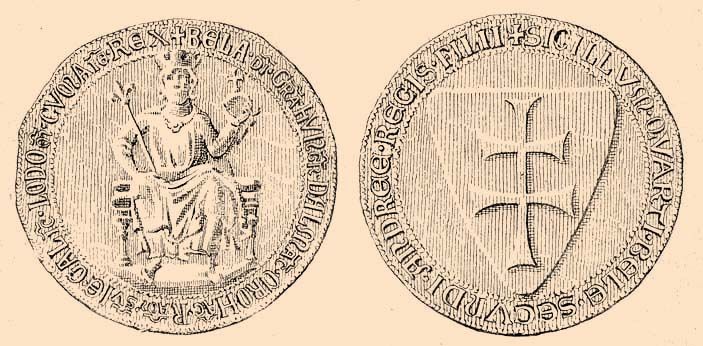
Béla IV's golden bull (seal) on a diploma from 1252. On the obverse is the king sitting on the throne, with a crown on his head, a lily sceptre in his right, and globus cruciger in his left. The inscription says: Béla, by the grace of God, King of Hungary, Croatia, Rama, Serbia, Galicia, Lodomeria, Cumania.
But on the 750th anniversary of his death, people can find no place in the city he founded where they could lay the wreath of remembrance. Which is very surprising, since Budapest is famous for erecting statues of famous people, the greatest Hungarians.
In the most important squares of Budapest, the greats of the nation, prominent historical figures, great patriots, uncompromising heroes, scientists, artists, and writers who glorify the nation look down on us from their pedestals several metres high. Earth mortals are reminded that these people stand above us in morals, knowledge, deeds, patriotism, or other virtues, and thus to serve as an example in our everyday struggles.
In addition to the famous Hungarians, statues of sons of other nations throughout the city can be found, often even foreign people whose lives and activities were in no way connected to the country and the capital. In 1906, a full-length statue of the first President of the United States, George Washington, the father of the American nation, was erected in City Park.
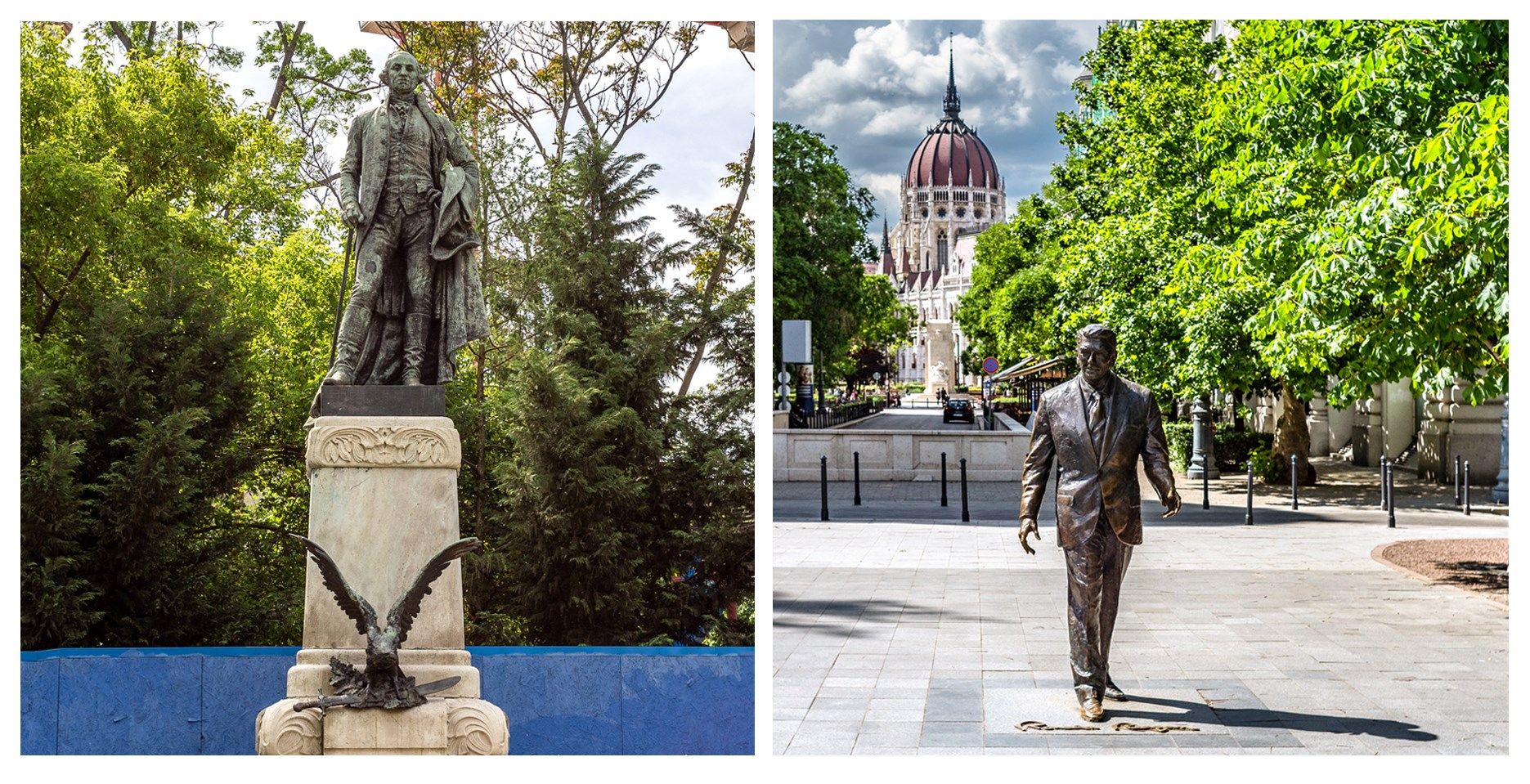
George Washington, the father of the American nation in City Park and Ronald Reagan in Szabadság Square (Photo: Balázs Both/pestbuda.hu)
In the Hungarian capital, there are two memorial sites of the American President Ronald Reagan, who passed away in 2004: a bust was inaugurated in the City Park barely two years after his death in 2006, and his full-length statue stands in Szabadság Square since 2011, near the American Embassy, the Soviet Monument, and the Hungarian Parliament.
The bust (made by Imre Varga) of British Prime Minister Winston Churchill (and Nobel Prize-winning writer), who died in 1965, was also erected in the City Park on the promenade named after him in 2003. The bust of the founder and first president of the Republic of Turkey, Mustafa Kemal Atatürk, who is called the father of the Turks in his homeland, was inaugurated in 1993 in Buda, Naphegy Square, and another in 2012 in the 19th District, Kispest, where the park that gave the memorial a place was also named after it.
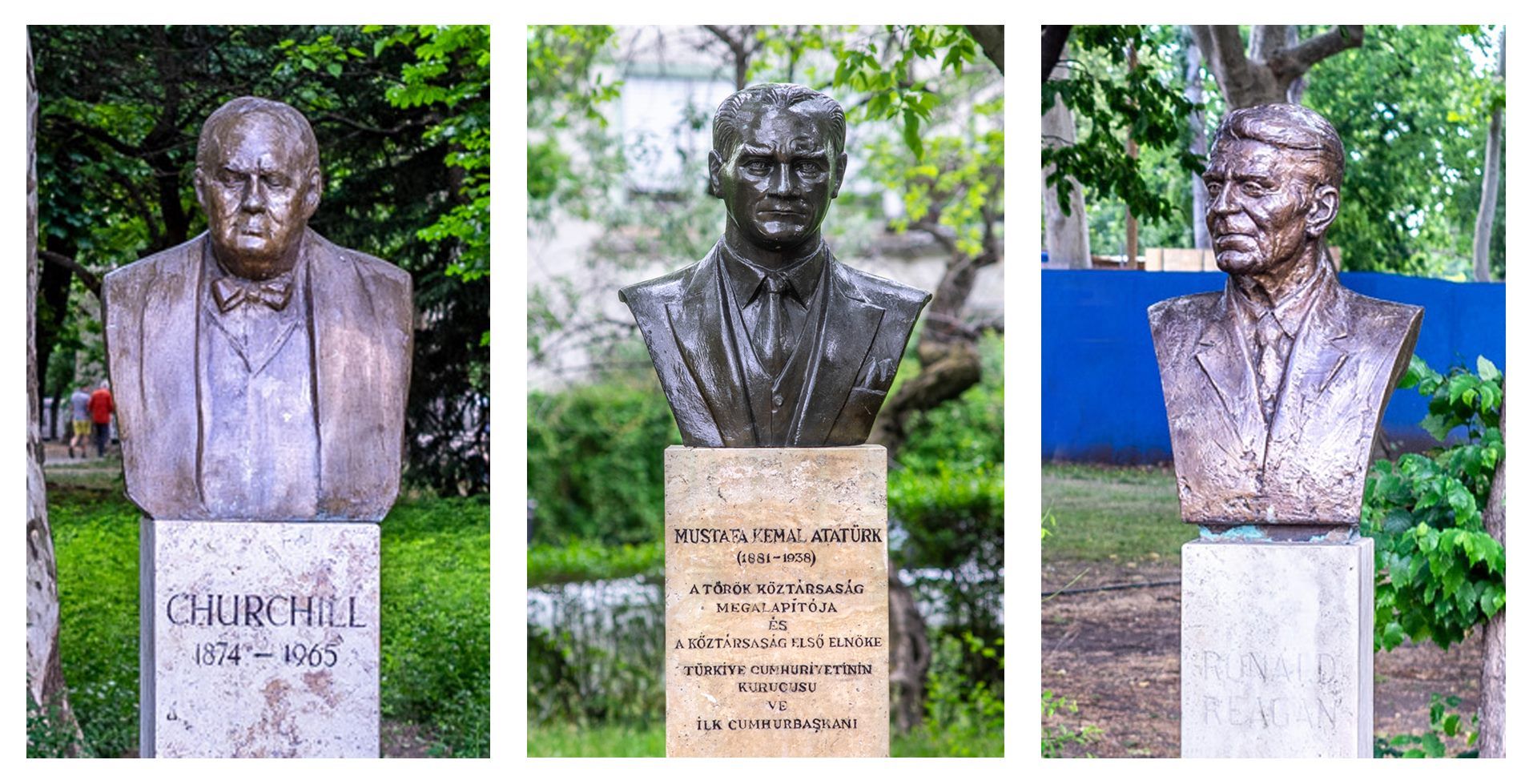
Winston Churchill in City Park, Kemal Atatürk in Naphegy Square, Ronald Reagan in City Park (Photo: Balázs Both/pestbuda.hu)
Even a little-known foreign ruler, such as Charles XII of Sweden who was famous for his drunkenness in his youth and regularly killed sheep in his palace until everything swam in all blood, has a relief memorial plaque in Budapest. And who has so much merit and connection to the Hungarian capital that in 1714, on his way home, he rode through our country. But there is also a statue of Simon Bolivar, one of the leaders of the South American War of Independence or Cuban freedom fighter José Martí, who probably did not turn up in the Hungarian capital, and the names could still be listed at length.
It is known from tour guides accompanying foreign groups on a sightseeing tour that Budapest is a real treasure trove for tourists visiting here: whether the guest comes from London, New York, Ankara, Stockholm or elsewhere, there are countless memories in Budapest related to their country and nation. Of course, foreigners happily discover the statues and other memorial sites of their compatriots in the Hungarian capital.
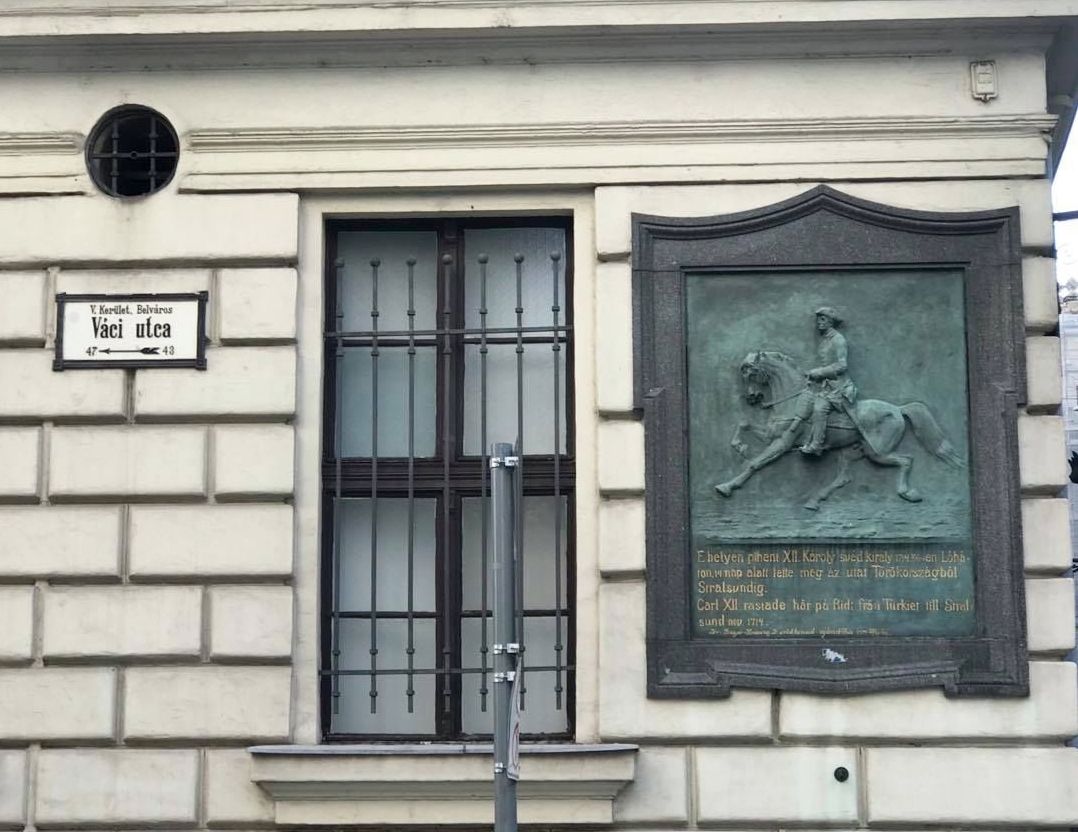
Charles XII of Sweden rode through the country. His relief plaque can be seen in the city centre, at 43 Váci Street (Photo: Csilla Halász/pestbuda.hu)
Béla IV, honoured as the second founder of the State did much more for this city than the foreign ones, far surpassing the riding through, but he does not have an independent monument in Budapest, and not even a plaque tells that Hungarians can honour the founder of the medieval Hungarian capital in the king.
It is true that on the outer facade of the Pest Vigadó, among the significant figures of Hungarian history, he had a place in the form of a portrait sculpture. At the Millennium Monument in Heroes' Square, one of the two arched colonnades surrounding the seven leaders sculpture groups, his figure can be found in the company of 13 other Hungarian historical figures, as well as on the facade and dome of the Parliament. But on this round anniversary of his death, we cannot wreath the building of the Vigadó or the Parliament, only perhaps the Millennium Monument made for the millennial anniversary of the conquest.
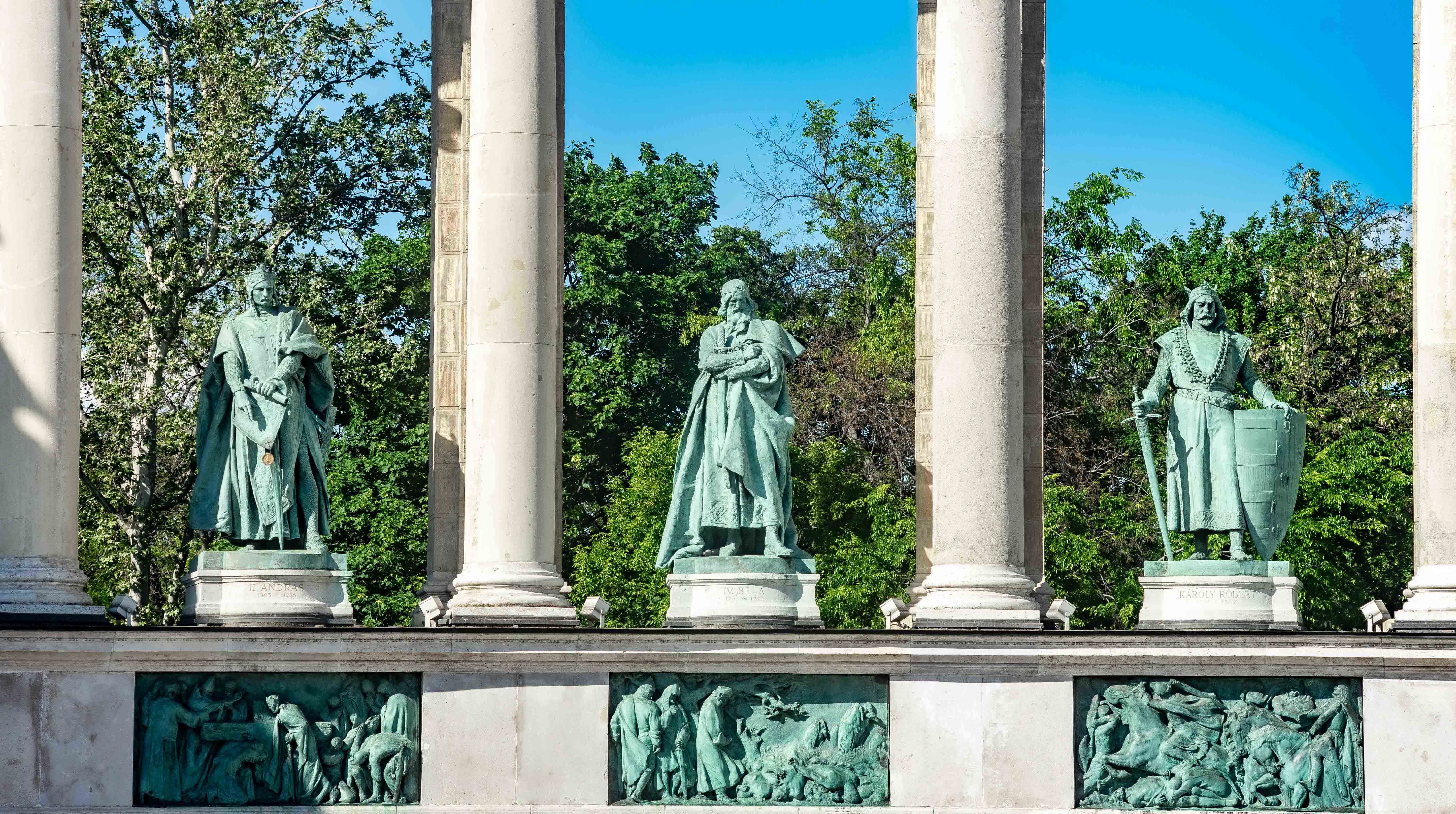 Among the 14 most important Hungarian historical figures, Béla IV also got a pedestal in the Heroes' Square at the Millennium Memorial (Photo: Balázs Both/pestbuda.hu)
Among the 14 most important Hungarian historical figures, Béla IV also got a pedestal in the Heroes' Square at the Millennium Memorial (Photo: Balázs Both/pestbuda.hu)
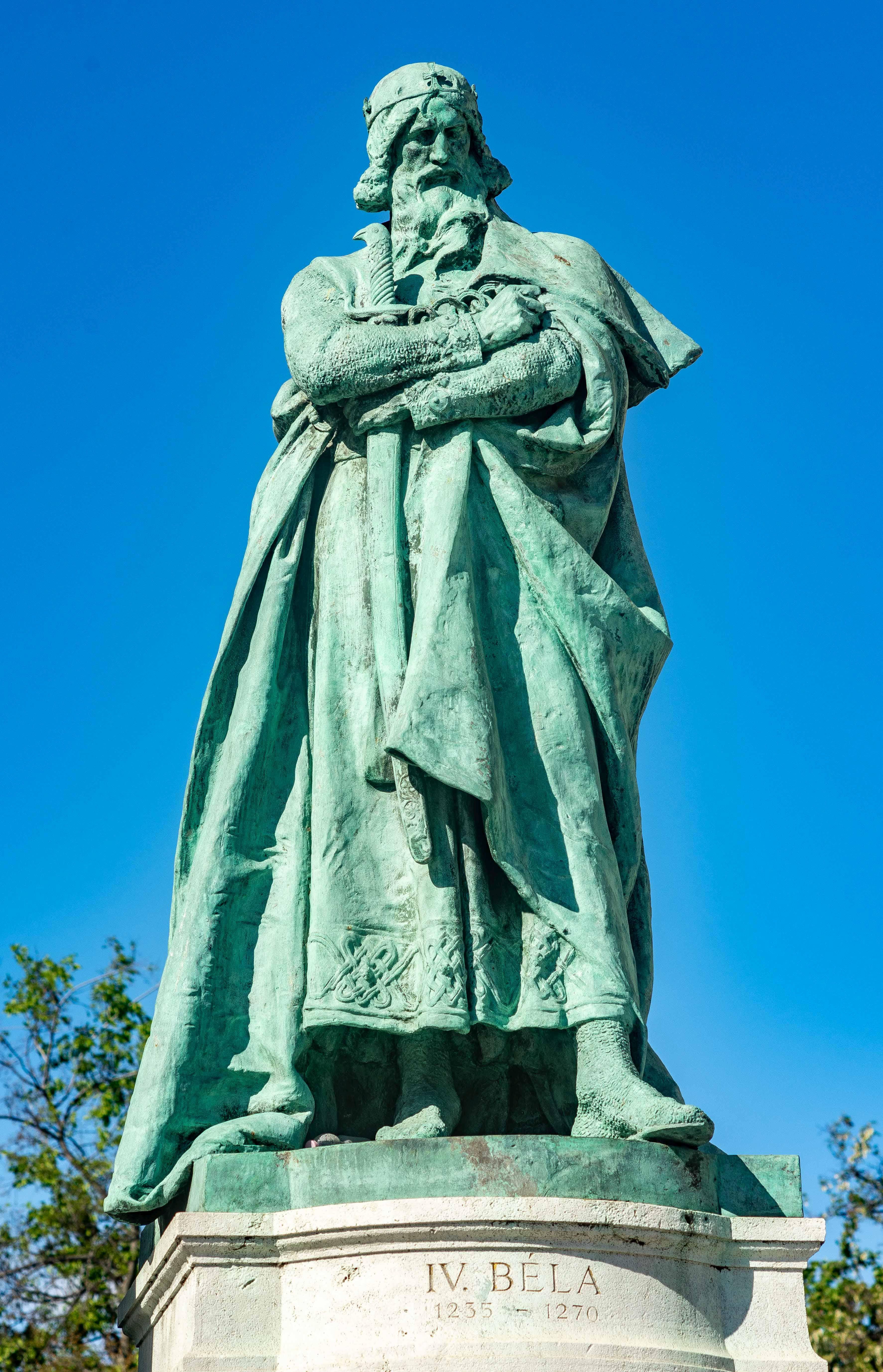
The statue on the Millennium Monument was made by Miklós Köllő in 1905 (Photo: Balázs Both/pestbuda.hu)
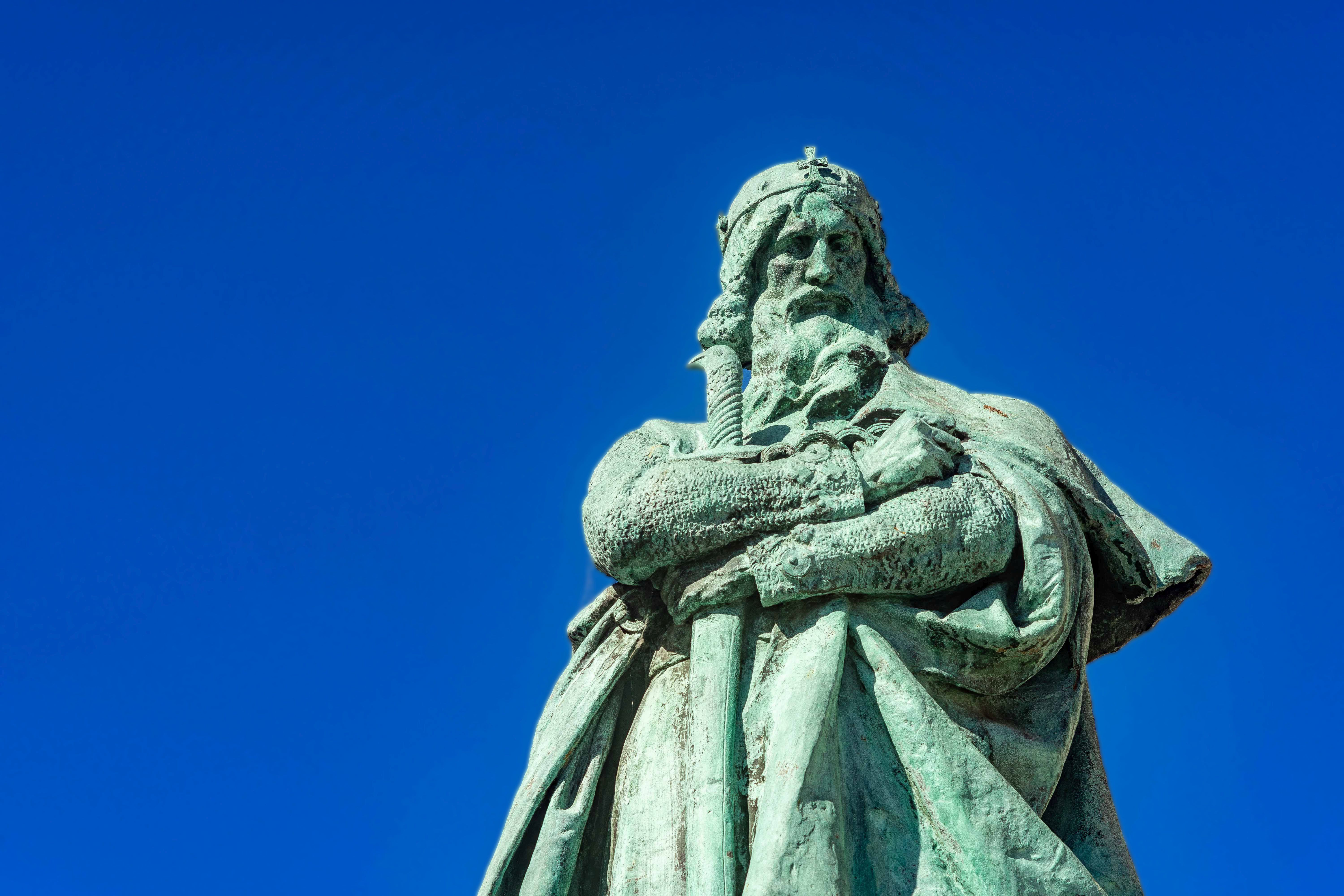 The beautiful Pest statue of Miklós Köllő does not compensate for the lack that the founder of Buda has no memorial site on Castle Hill, the city that owes its existence to him (Photo: Balázs Both/pestbuda.hu)
The beautiful Pest statue of Miklós Köllő does not compensate for the lack that the founder of Buda has no memorial site on Castle Hill, the city that owes its existence to him (Photo: Balázs Both/pestbuda.hu)
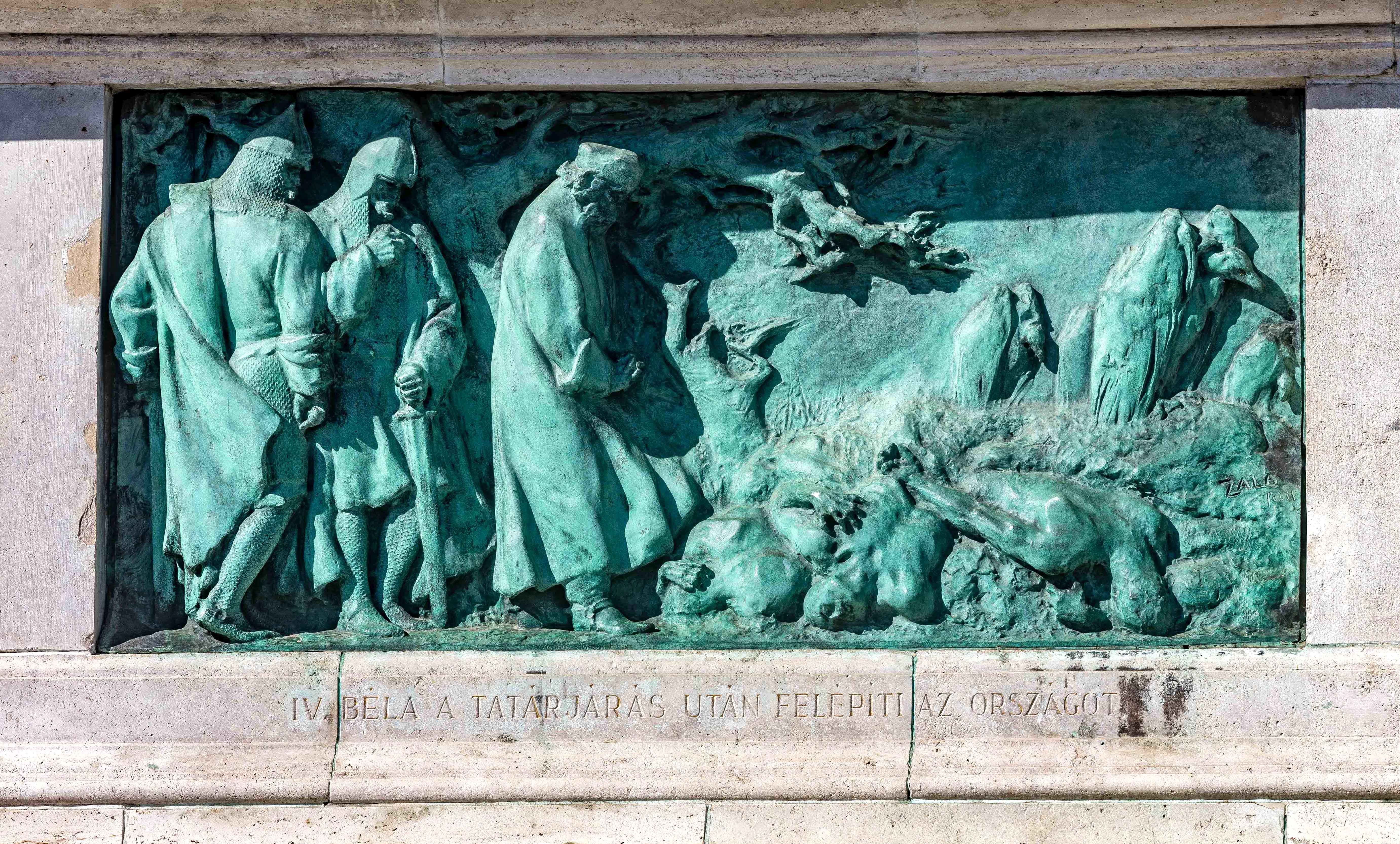
This relief is in Heroes' Square, below the statue of Béla IV, the inscription says: Béla IV builds the country after the Tartar invasion (Photo: Balázs Both/pestbuda.hu)
The statue of Béla IV is located on the facade facing the Danube in the building of the Parliament. From here visitors can look over to the other side, the ungrateful Buda, which, like Pest, have had many memories of many sons of other nations, but its founder has been completely forgotten in the 750 years since his death.
But what can Béla IV see from the Danube facade of the Parliament, the height above the loggia on the main floor, if he looks over to the other side? Who has an honour over there? Turning to the north, in Bem Square, he would see the Polish József Bem, to whom they rightly erected such a beautiful monument in 1934 (the work of János Istók), as he fought for Hungarian freedom.
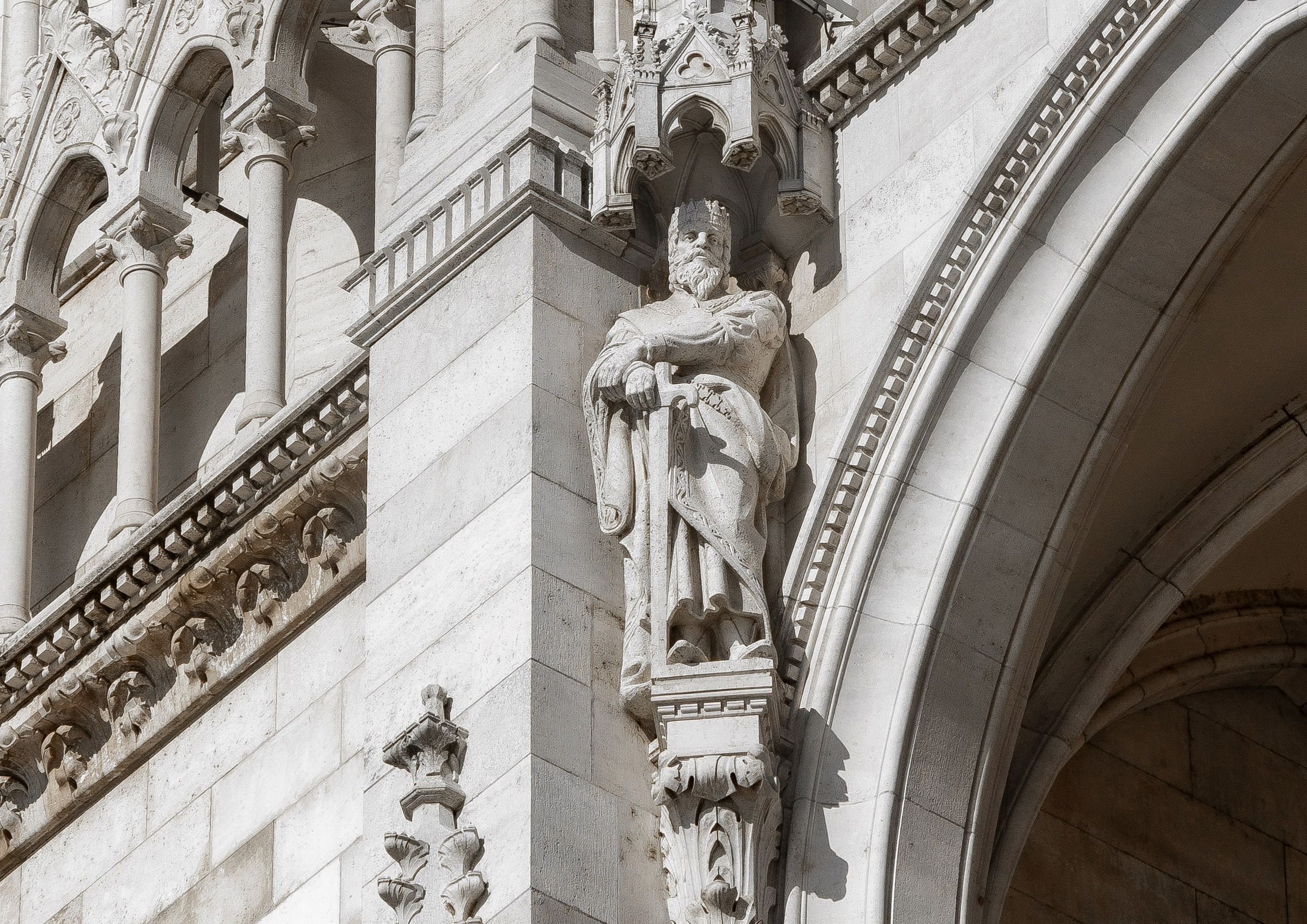
Béla IV on the Parliament building (Photo: Balázs Both/pestbuda.hu)
Further south, in Batthyány Square, it would be difficult to take on the figure of our national poet, Ferenc Kölcsey. Although a copy of the Nagykároly statue, which was destroyed by the Romanians, was inaugurated in the middle of the square in 1939, the work of Ede Kallós was demolished in 1950, referring to the construction of the underground, and it was brought back to the edge of the square in 1974, deprived of its pedestal. Opposite him, on the other side of the square, he would see the statue of Lajos Batthyány, the first Hungarian prime minister, who paid for this distinguished position with his life. The work of Géza Stremeny, which is much smaller in size than the figure of Bem, was erected in 2008.
Further south, on Castle Hill, behind the Fisherman's Bastion, he would see the statue of his great ancestor, King St. Stephen, the work of Alajos Strobl, though he stands with his back (on his horse) to the city, because he turns to the Church of the Assumption, and he could not even walk in the Castle, as Buda did not yet exist in his life.
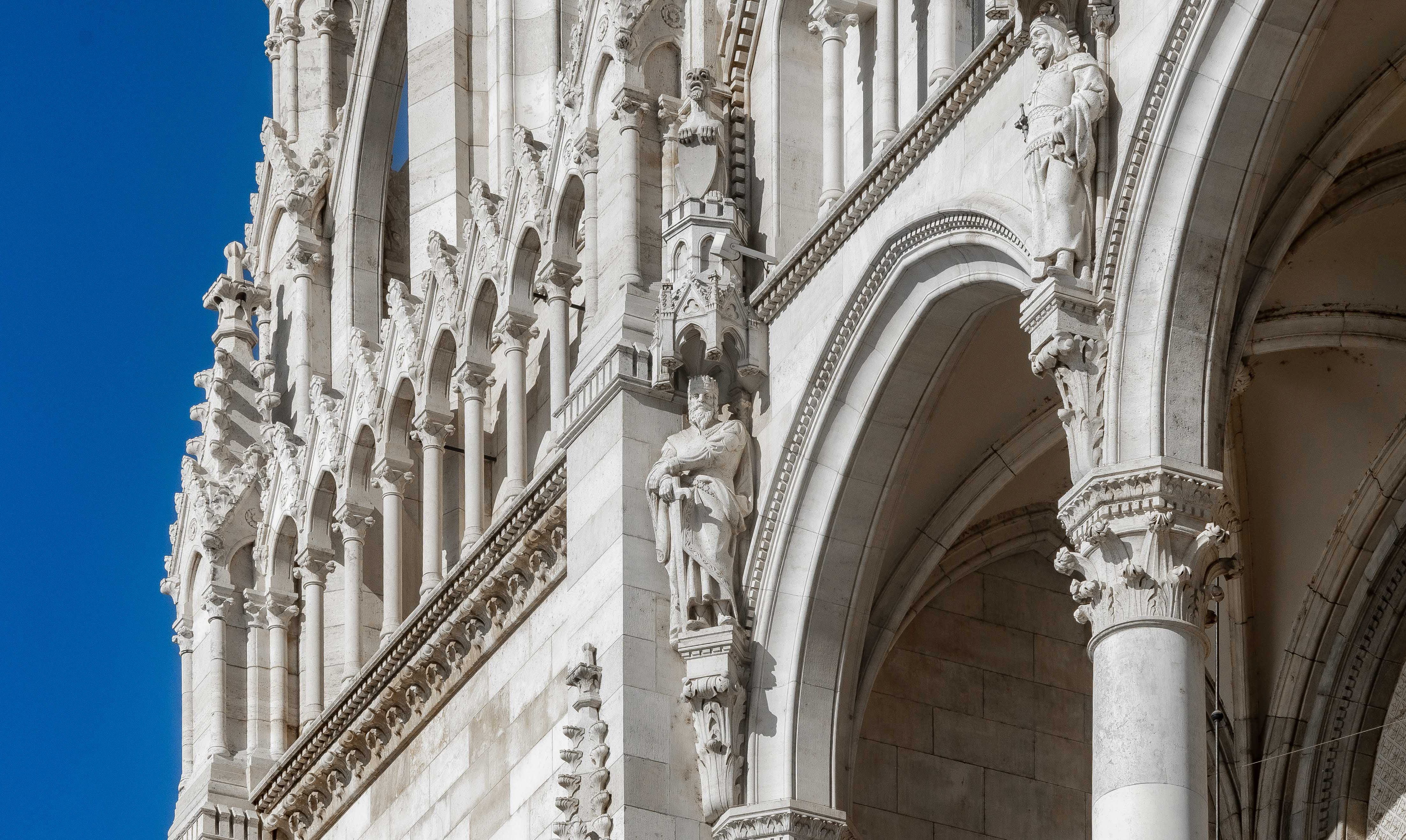
Béla IV is the first on the left of the 8 king statues above the main floor loggia (Photo: Balázs Both/pestbuda.hu)
Looking further south, he would be shaken to see that in Buda, which he founded, on the Castle Hill ridge in front of the palace, there is the statue of Prince Eugene of Savoy, an Austrian imperial soldier placed here by mistake that occupies the symbolic place that might should be the Béla IV's, the founder of the city.
He would probably not be comforted that other cities in the country have not been so forgetful and faithfully cherish his memory to this day. In many settlements works made about him can be found on the border from here and beyond.
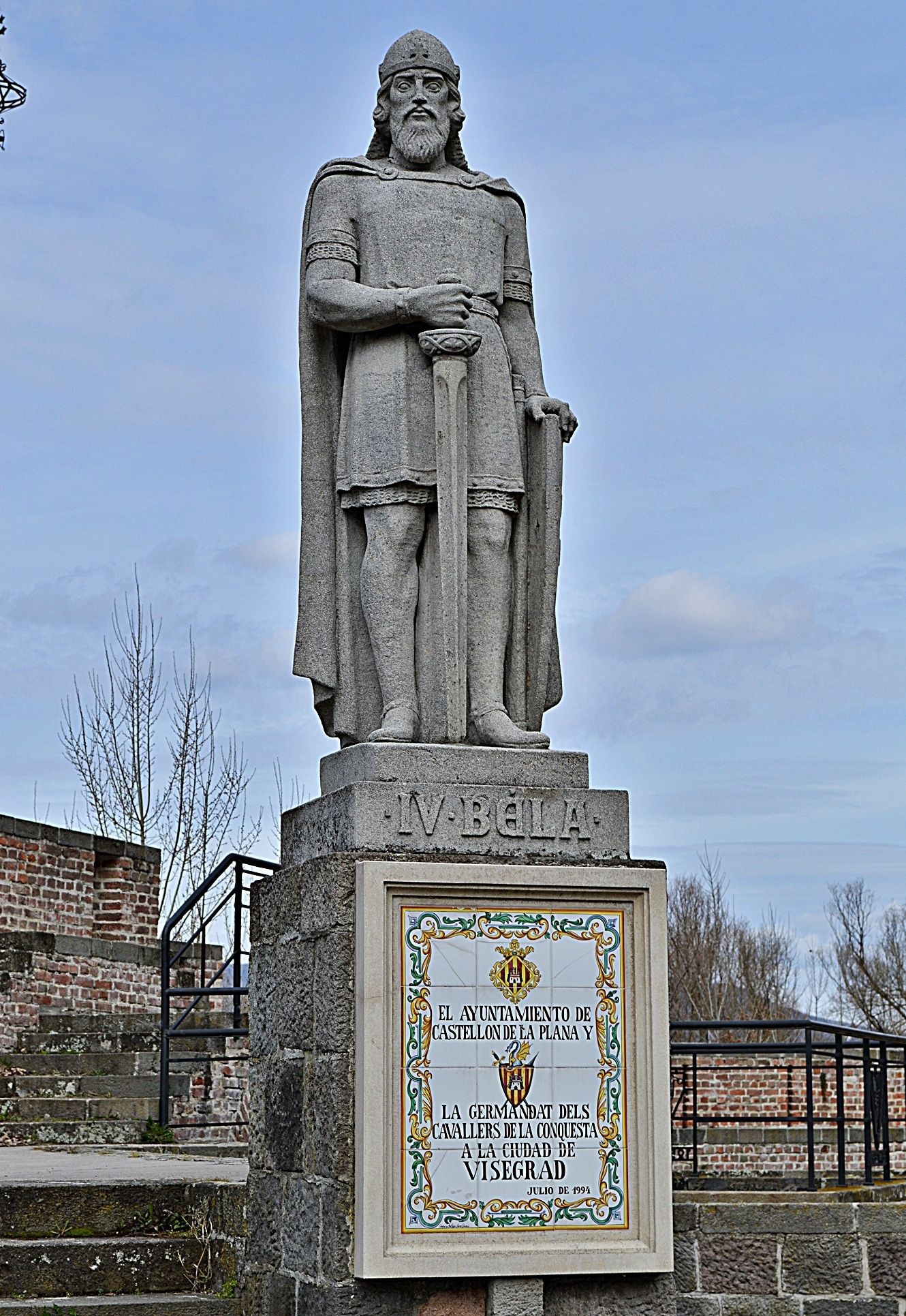
The statue of Béla IV, the work of Lajos Krasznai, was erected in Visegrád in 1939
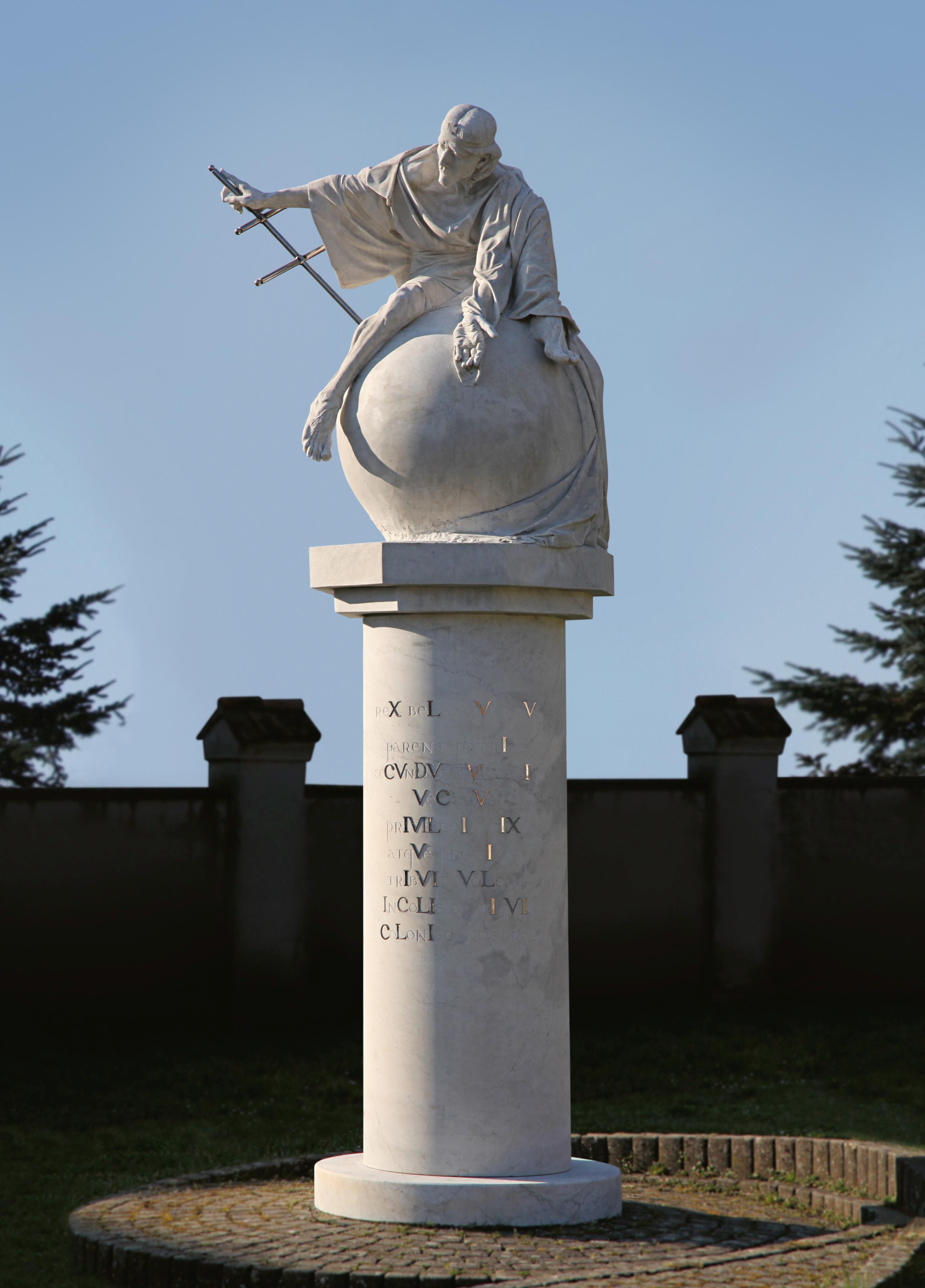
The work of Péter Párkányi Raab was inaugurated in Körmend in 1994
In Visegrád, where after the Tartar invasion of 1241-1242 Béla IV had a castle built, a huge monument to the ruler was erected at the gate of the town. Full-length or equestrian statues and busts perpetuate him in Csécs, Dunakeszi, Kimle, Körmend, Szeged, Szentpéterszeg, Veszprém, Zalaegerszeg, among others, reminding the late descendants of the never-expiring merit of rebuilding Hungary after the Tartar invasion.

The statue of Béla IV, the work of Lajos Győrfi, was handed over in Szentpéterszeg in 2000
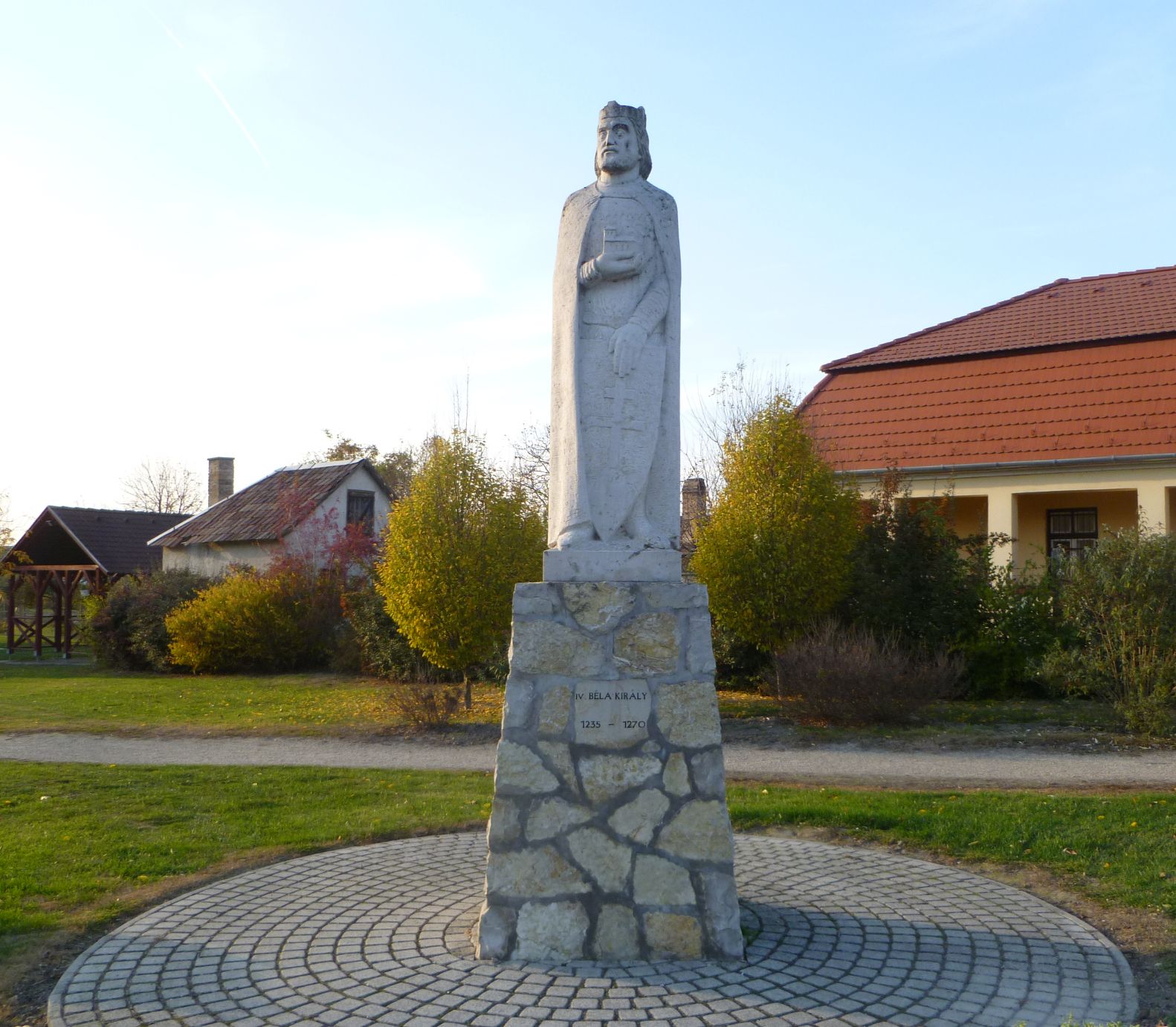
The work of Tibor Rieger has been on display in Kimle since 2001
Béla IV did much more for Budapest than for other cities, so it makes a person feel especially lacking that he does not appear as a city founder, but this is not surprising at all. In the capital, from 1858, when the first public memorial to József Katona was erected, the capital, governments and sculpture committees were able to commemorate important or famous people in campaigns.
The greats of the Hungarian nation were never counted, so there could be no well-thought-out memory policy adapted to this. Thus, it was mostly a coincidence that a historical figure, a famous writer, a great painter, an excellent composer would receive a full-length sculpture with a multi-metre pedestal in central squares or that a small bust would appear of them in a hidden street. In many cases, it was up to the initiator, who did not know the Hungarian heritage in the context, of whom a statue or memorial plaque was erected in the capital.
Plannedness and consciousness characterised the dictatorial decades between 1945 and 1989, but then they did not take into account the greats of the nation, but they flooded Budapest with statues and plaques made of the domestic and foreign theorists, chief ideologues, dictators, rulers, supporters, followers, glorifiers, devotees, warriors, representatives of communism, socialism and the labour movement, and named streets, schools, institutions, awards after them - completely erasing the past, as formulated by The Internationale.
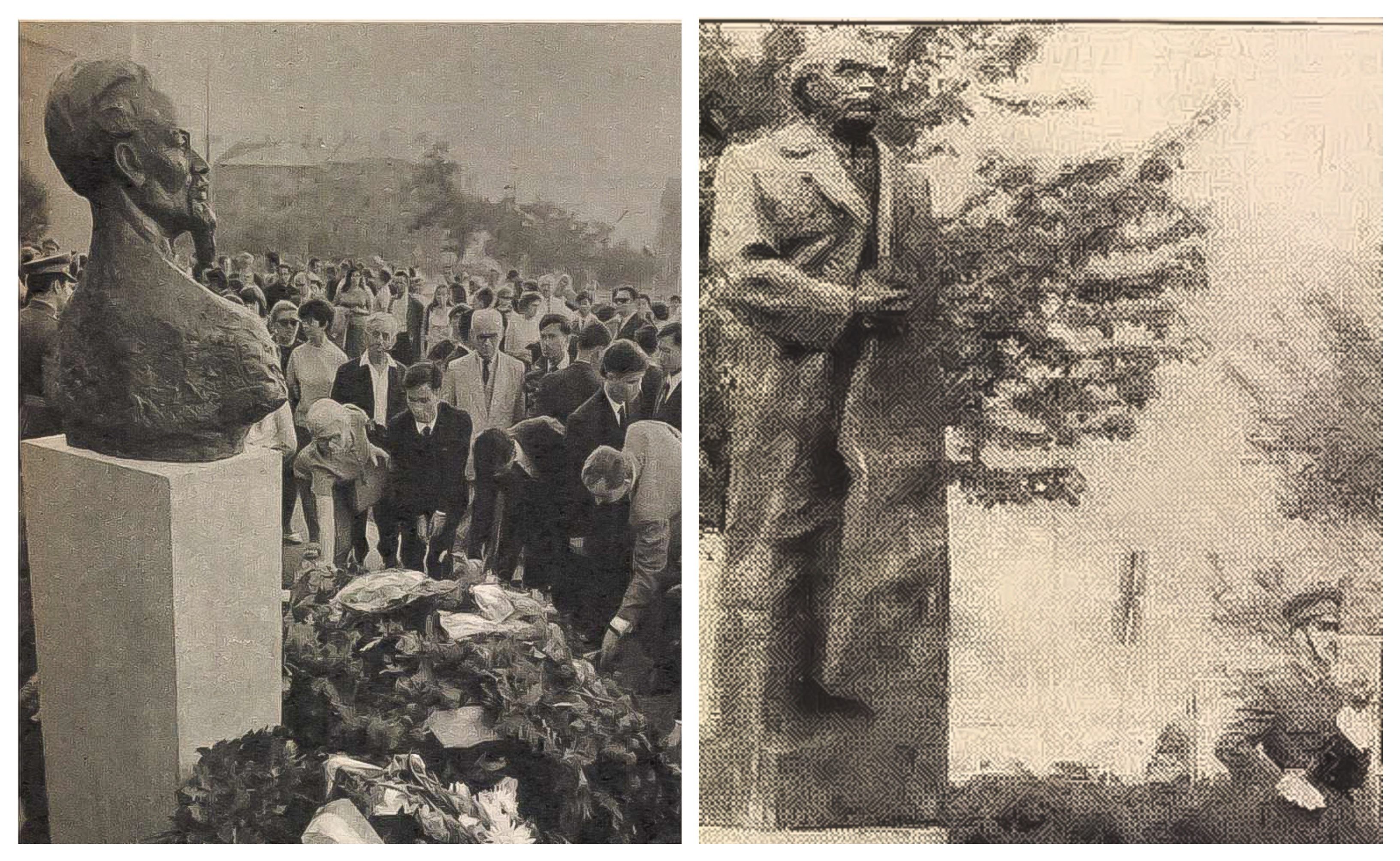
Left: The statue of the Communist leader of Vietnam, Ho Shi Minh, was inaugurated in 1970 in Hanoi Park (now Independence Park) in Budapest, and was removed in 1991 (Source: Tükör, 8 September 1970). Right: Inauguration of the statue of Bulgarian Communist leader Georgi Dimitrov in 1983 on Dimitrov Square (now Vámház Square), it was put in place of the bust made in 1954, and was removed after the change of regime (Source: Népszabadság, 12 May 1983)
The members of the ruling class at the time believed that the street works were the public advertising spaces of the existing system, the main promoters of the rewritten Hungarian history, and spread the worldview they represented more effectively than anything else. This propaganda was so successful that it has left indelible traces in Hungarian public thinking.
The age of Béla IV, the founder of Buda, had no such campaigners, so if a tourist walks through the ancient streets of the Castle today, he remembers King Matthias, the Ottoman occupation almost beautified by numerous Turkish names, the recapture of the city from the Turks in 1686, and then in 1849 from Austrian imperial forces, Mihály Táncsics, who was released from the castle prison on 15 March 1848, and later became a disseminator of socialist ideas, perhaps due to the Sándor Palace, Gyula Andrássy, who transformed the building into a prime minister's residence, possibly Franz Joseph, during whose reign built the Neo-Baroque royal palace, but does not remember Béla IV who founded and built the city.
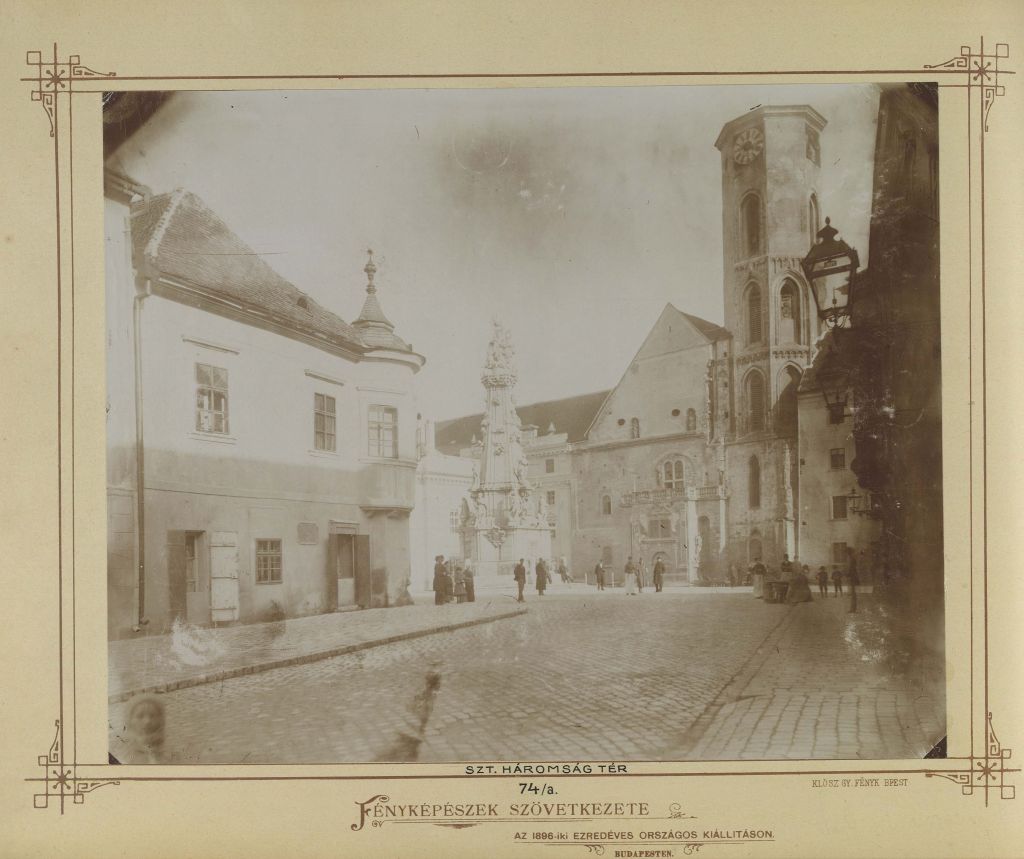
Béla IV founded the Church of the Assumption (Matthias Church), which is first mentioned in written sources in 1247, to its left is the Statue of the Holy Trinity (Source: FSZEK Budapest Collection, recording by György Klösz from 1874)
The development of memory is significantly influenced and possibly distorted in the Castle District as well by what can be seen in public areas - and the figure of Béla IV does not appear.
Yet in the Castle District quite a lot of public sculptures can be found. The oldest work of art does not depict a person: after the great plague of 1691, the citizens of Buda erected a votive column in front of the Church of the Assumption: The Statue of the Holy Trinity, which is still visible today, was handed over in 1713. Also, in the Szentháromság Square the ornamental well decorated with the statue of Pallas Athena was erected in 1785, the work was later placed on the corner of the Buda City Hall (although today only a copy can be seen).
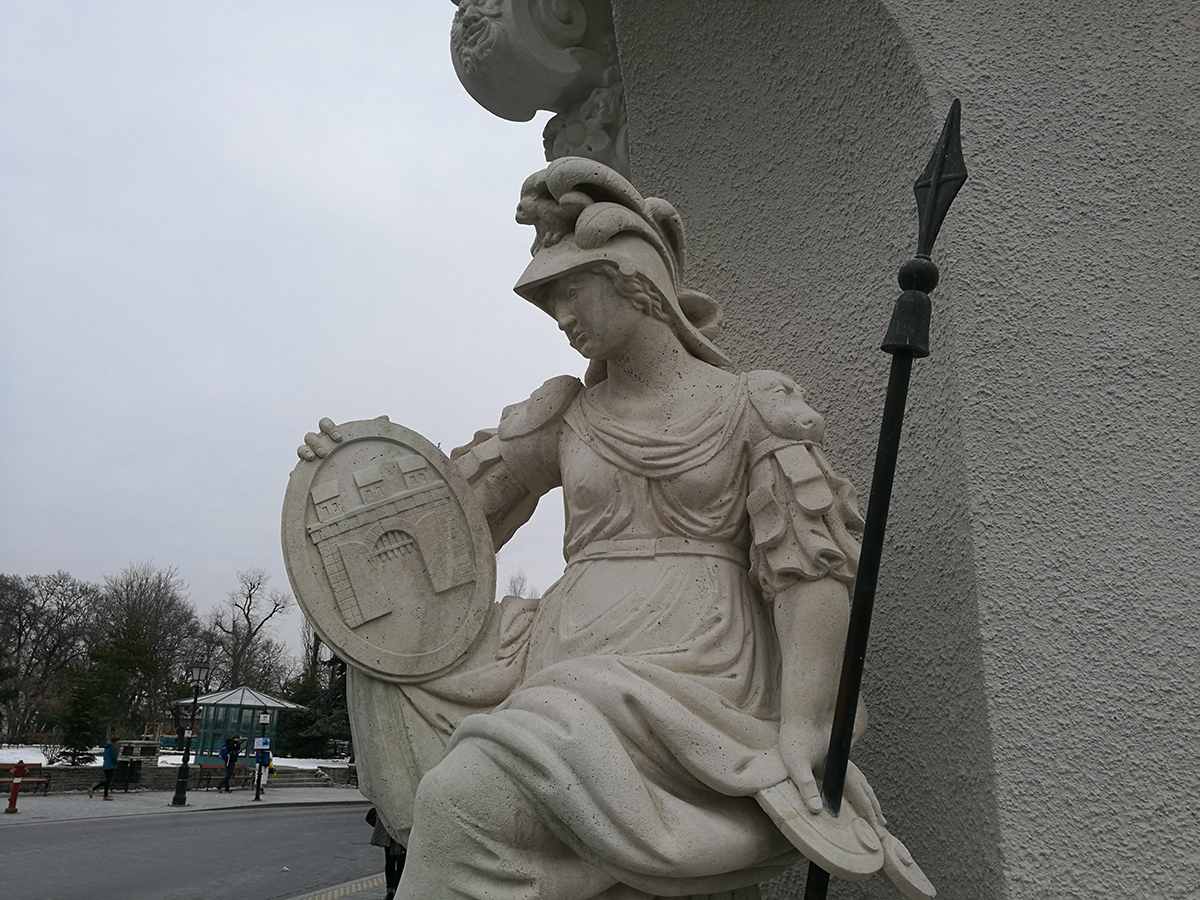
The statue of Pallas Athena can be seen in Szentháromság Square; it was originally a well statue (Photo: Péter Bukovszki/pestbuda.hu)
The first public work in Buda Castle (and the first in the capital) that erected a monument to a real person was the Hentzi monument commissioned by Franz Jospeh and placed in 1852 on Szent György Square; the Austrian military commander of the Castle received a fatal wound on 21 May 1849, when the army recaptured Buda from the Austrian imperial forces. The central statue of the 22-metre-high column made of ore (cast iron), the dying armoured warrior, over whose head an angel held a laurel wreath, only hinted at the Austrian military officer, his face covered with a helmet grille.
The main sin of General Hentzi in the eyes of the people of Budapest was to shoot from the Castle the beautiful rows of palaces on the banks of the Danube in defenceless Pest. The work made in his memory was a symbol of oppression for Hungarians for decades, in the words of Lajos Kossuth, a slap in the face to the nation.
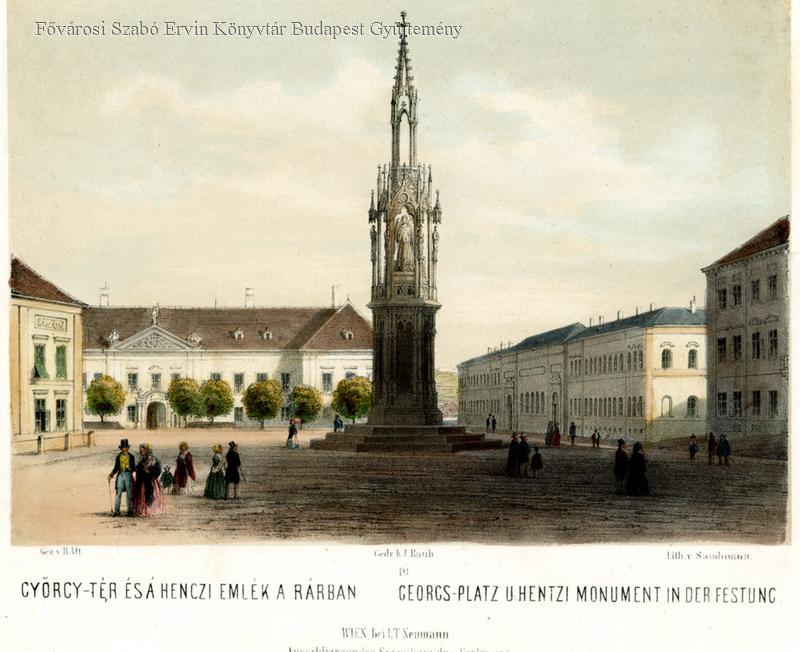
The Hentzi Monument in the Castle, on Szent György Square in 1889. It was only removed in 1899 (Photo: FSZEK Budapest Collection)
When the Hungarian monument of the same battle of 21 May 1849 was erected in Dísz Square in 1893, proclaiming the glorious deed that the Armed Forces managed to take Buda Castle back from the Austrians, the controversial situation arose that the Honvéd Statue designed by György Zala, which brought the Hungarian victory to life and the Hentzi Memorial, which commemorates Austria's loss, were separated by barely two hundred metres. The column hated by the Hungarians was only removed from the Castle in 1899.
The citizens living here could not rejoiced for long that they had got rid of Hentzi, because soon a monument to an Austrian imperial soldier stood in the Castle, namely that of Prince Eugene of Savoy, whose equestrian statue was erected in 1900 in the garden of the royal palace overlooking the Danube.
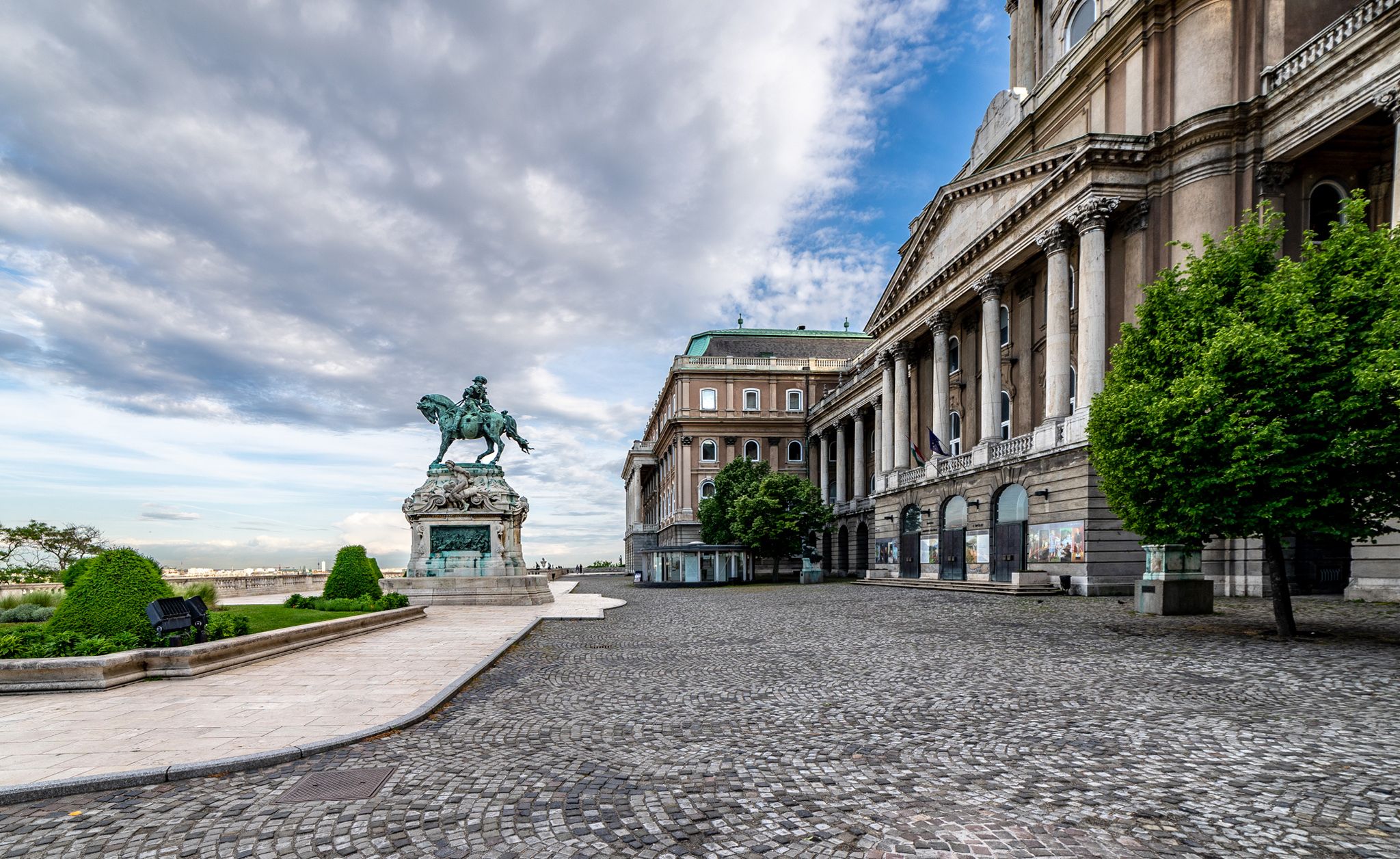
The statue of a French-born Austrian imperial military officer, Prince Eugene of Savoy, in front of the Buda Castle. It was not made for here, but for Zenta, in memory of the battle of 1697 there (Photo: Balázs Both/pestbuda.hu)
It is a shocking falsification of history that on the ridge of Castle Hill, on the terrace of the palace overlooking the Danube, on the most important sculptural site of the capital, which belongs to the greatest Hungarian ruler, there is an equestrian statue of a French-born Austrian imperial soldier. How Prince Eugene of Savoy (as it is called on the sculpture base) was placed here, occupying the place of King Matthias, who built the magnificent Renaissance Buda Palace, or the founder of the city, Béla IV's? It is known from Alajos Hauszmann that it was only temporarily placed in front of the palace, so it stayed here by mistake.
It is safe to say that the presence of this statue contributes to the recording of historical errors. Due to its position in front of the palace, from where he looks down on the city, Buda and Pest, the beautiful Danube at his feet, any Hungarian high school student could rightly believe that we owe him the liberation of Buda from the Turks, although this is not true at all. He fought here in 1686, at the age of 23, but the recapture of Buda was directed by Charles V, Duke of Lorraine, and Prince Eugene of Savoy became a great Turkish beater only in later years, so the French prince and Austrian imperial military officer was neither the hero of Buda nor of this nation and could never get close to the hearts of the Hungarians.
Criticism of Prince Eugene of Savoy's statue's placement in Buda Castle appeared even before its erection. "Thus, in front of the royal castle, a figure of our story will be immortalised that is not really ours, and whose approach, although it evokes the memory of great military service, will not even elevate the national feeling." - wrote the Pesti Hírlap on 26 May 1900. The same paper would take the work away from its place next year and suggests erecting Matthias instead. “And the equestrian statue of Prince Eugene of Savoy could be set up in one of the courtyards because he is not a national hero for us. (...) How beautiful would be the equestrian statue of King Matthias on the front terrace of the royal palace!” - wrote Pesti Hírlap on 10 November 1901, for example.
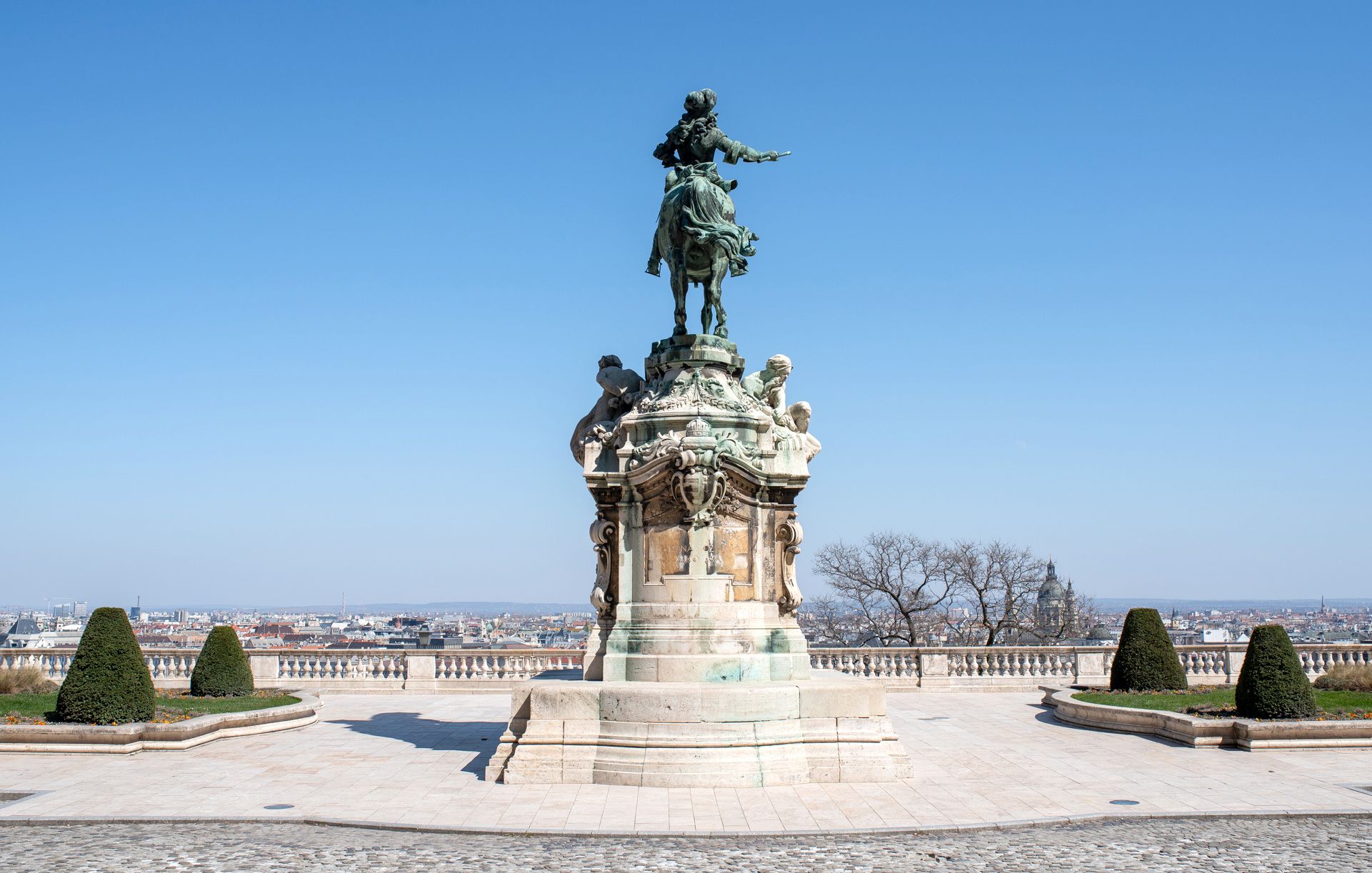
Prince Eugene of Savoy looks down on the city, Buda and Pest, the beautiful Danube lying at its feet, from its position anyone can rightly believe that we owe him the liberation of Buda from the Turks, although this is not true at all (Photo: Balázs Both/pestbuda.hu)
And although in later years, in 1904, the figure of one of the greatest Hungarian rulers, Matthias, appeared in the courtyard of the palace (rightly so, as his palace used to stand in this area), but only in the form of a well statue: Alajos Strobl's work depicts the hunter not the ruler.
The figure of Béla IV, the founder of the city, did not occur to anyone in the later years, although the symbolic politicisation of the Buda Castle continued with new sculptures. As a result of the millennium celebrations, the themes of the millennium anniversary of the conquest and the founding of the state also appeared: The statues of the conquering leaders, Álmos and Előd was erected in 1902, and the monument of St. Stephen, the work of Alajos Strobl was inaugurated in 1906 in the embrace of the Matthias Church and the Fisherman's Bastion.
The number of sculptures increased between the two world wars in the city of Béla IV. First, after the losing war and the tragic Trianon decision, a monument to the Italian theologian and preacher John of Capistrano was made in 1922, on Nándor Square - it is known about him that in 1455, he visited Buda and stayed in the Franciscan monastery founded by Béla IV. But he probably did not deserve the statue with this, but as the leader of the crusade of the battle of Nándorfehérvár (he died of a plague shortly after the triumph, like János Hunyadi).
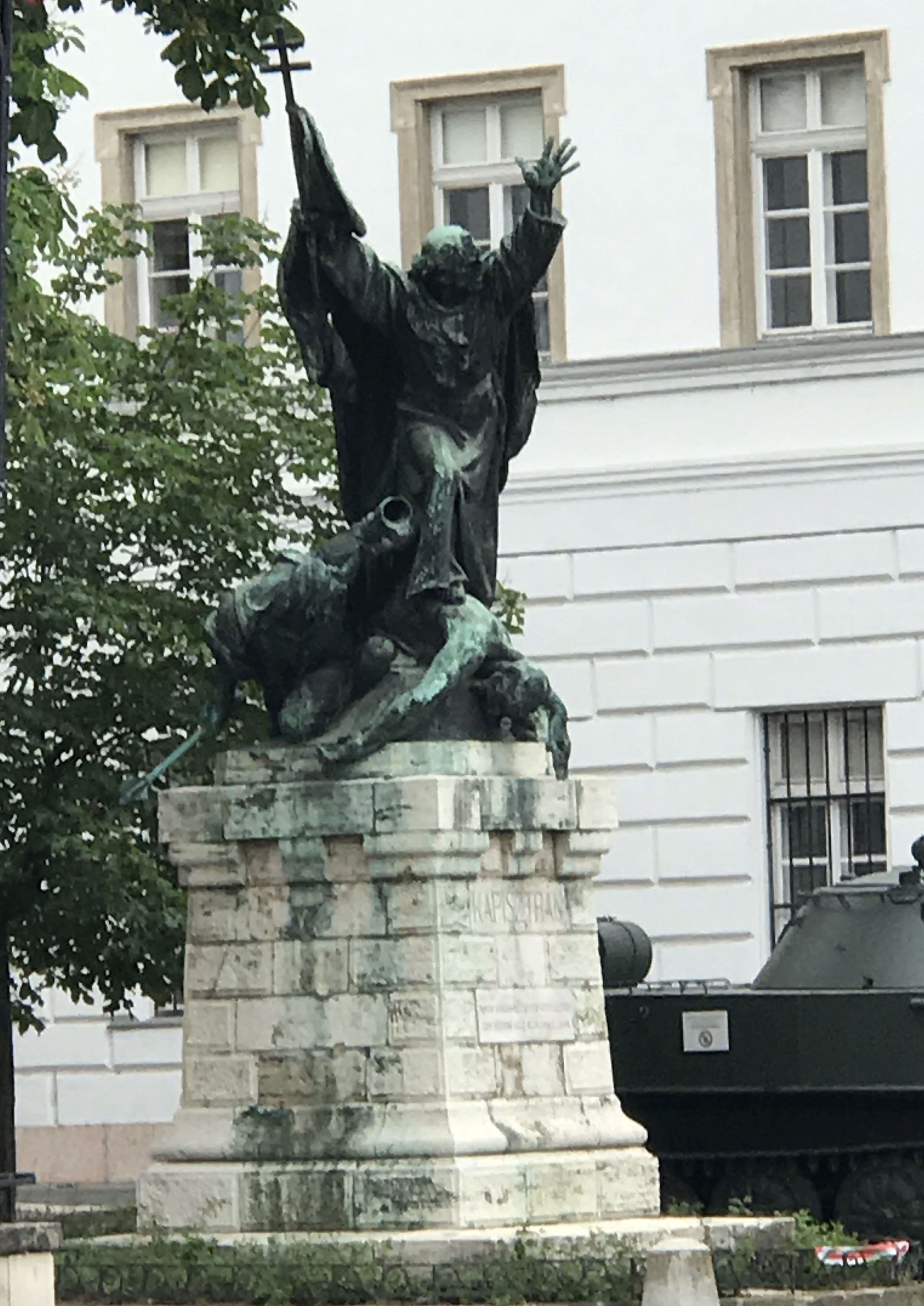
Statue of John of Capistrano in the square named after him (Photo: Csilla Halász/pestbuda.hu)
Not for the founder, but for the oppressor a memorial was made in the Castle, this also testified to the unrecognizability of the Hungarian soul. For surely there is no other nation that commemorates its own enemies, its murderers. The symbolic tomb of Abdurrahman, a former pasha from Buda who fell during the recapture of Buda in 1686, has stood on the Anjou bastion since 1932, and was erected voluntarily by our ancestors (unlike the Hentzi Monument).
This special monument testifies that Budapest is the city where a public artwork can be created from a private initiative, no matter how absurd. And in addition, this generous gesture rewrites history: the symbolic tomb of a Turkish soldier who subjugates and kills Hungarians is transformed into a monument to a heroic dead.
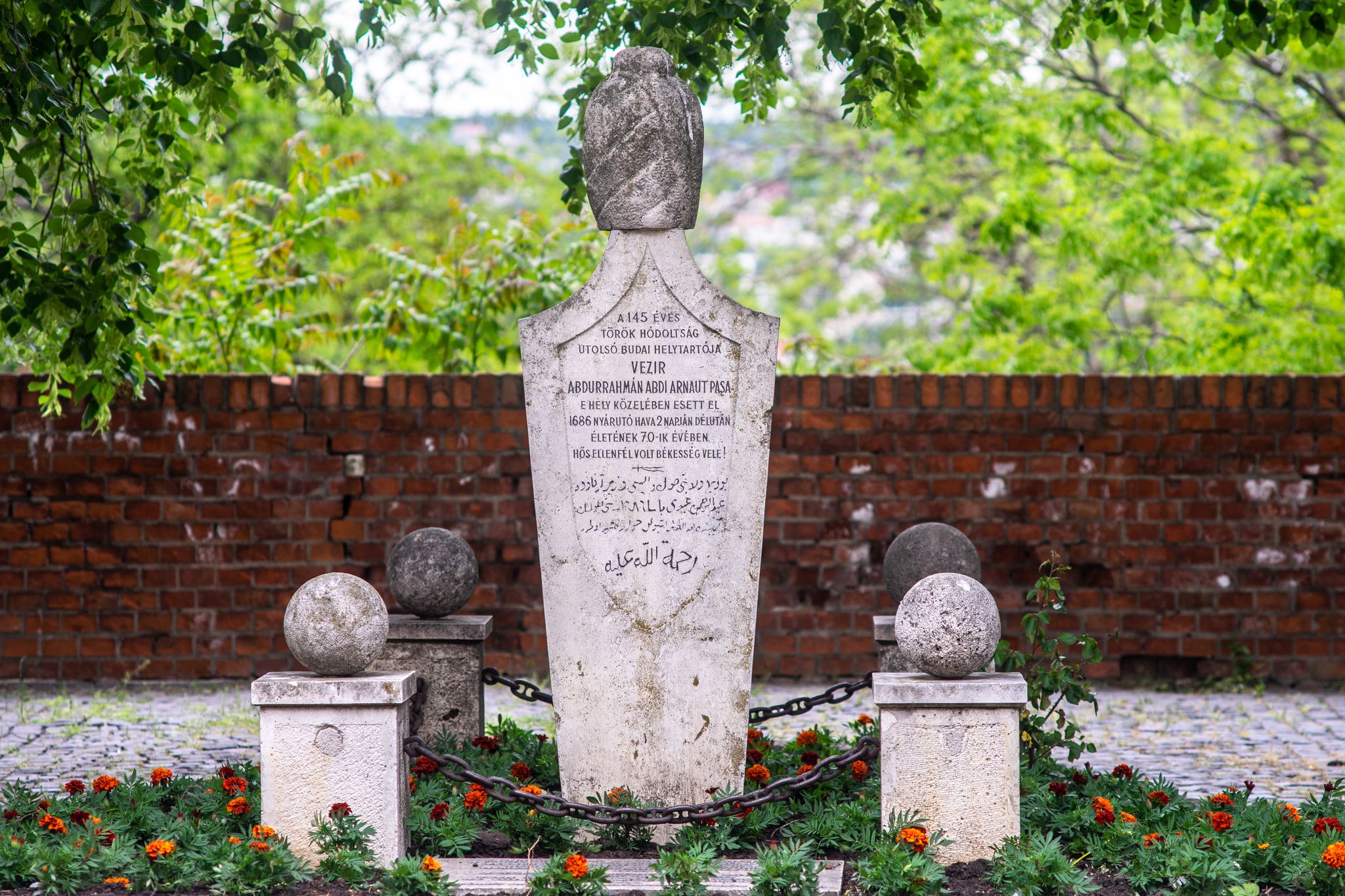
This symbolic “tomb” also contributes to beautifying the memory of Turkish rule, which destroyed a significant part of the country’s population, persecuted Christians and turned their temples into mosques (Photo: Balázs Both/pestbuda.hu)
The falsifying role of this public artwork cannot be neglected either: in the elementary school history book, but even on the website of one of our prestigious museums, people can read that Abdurrahman's tomb is here, although of course the ashes of the last occupying Buda pasha are not here. Where could they have been collected it 246 years after his death?
After the inauguration of the symbolic tomb of the Buda pasha, the inability appeared in the Buda Castle as it was a monument to the oppressor and conqueror before the liberation of the city from the Turks. The monument to the recapture of Buda Castle from the Turks was inaugurated only four years later, in 1936, in the Bécsi Gate Square. In the same year, on the 250th anniversary of the liberation, a statue of Pope Innocent XI was handed over in 1936 on the former Iskola Square (now Hess András Square), also because of his role in the fight against the Turks.
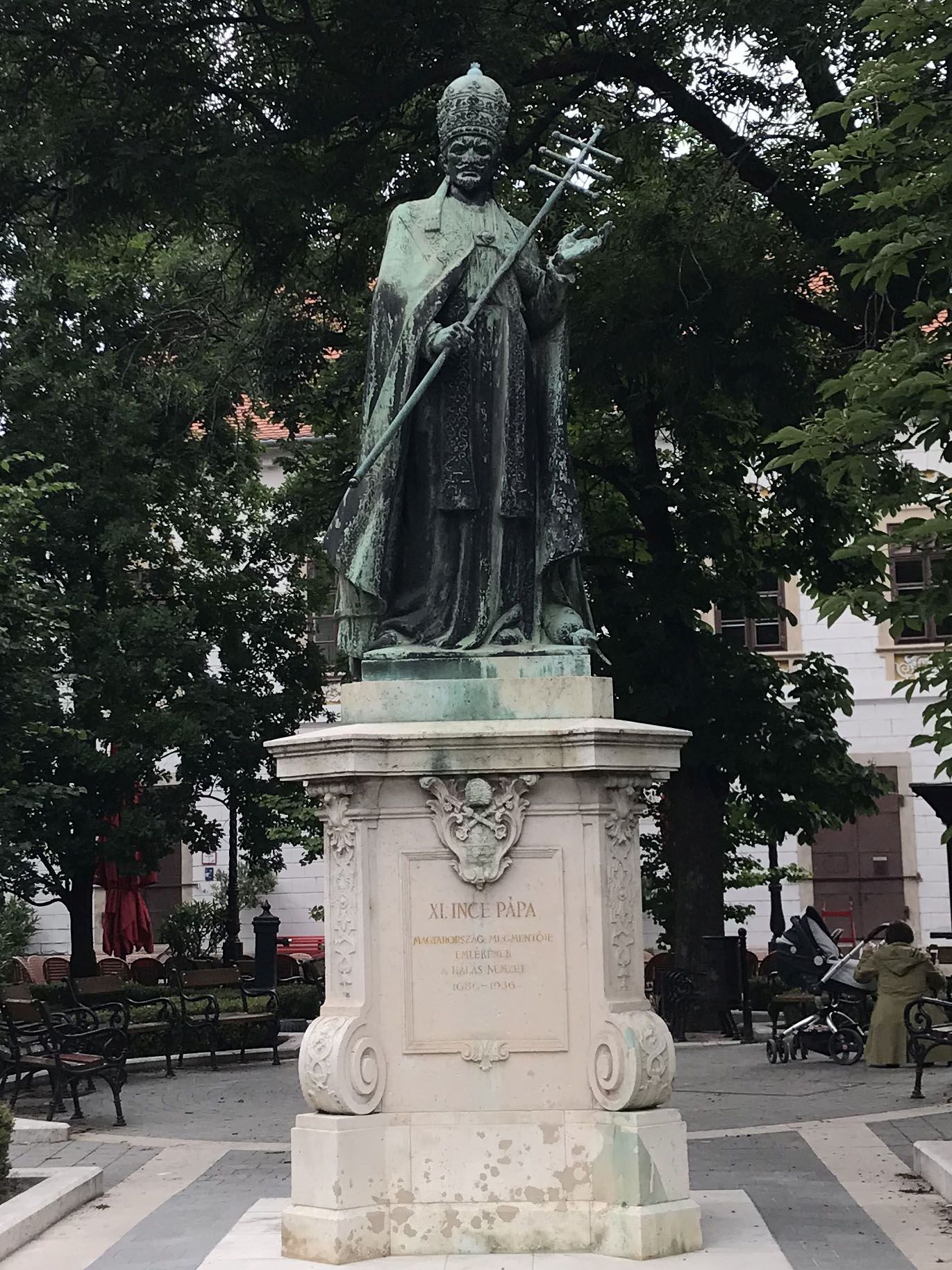
The statue of Pope Innocent XI was unveiled on the 250th anniversary of the takeover of Buda Castle in Iskola Square (today's Hess András Square) (Photo: Csilla Halász/pestbuda.hu)
An equestrian statue was inaugurated to Artúr Görgei in 1935 in front of the Military History Institute and Museum (demolished in 1945 and erected again in 1998, in a new location, on the Fehérvár Rondelle). Then, on the corner of Úri Street - Szentháromság Street, in 1937 András Hadik also received an equestrian statue, which is also the Monument of the third Hussar Regiment.
And in the Castle,many other works can be seen: ornamental wells, actor Márton Lendvay's, The Old Hussar's and the second hussar regiment of Transylvania's monument, works around the palace (Csikós Statue, War and Peace, Csongor and Tünde, Bonfini). Moreover, after the change of regime, new statues were erected here, for Count István Bethlen (by Géza Stremeny) in 2013 in Szent György Square, and for military officer Ferenc Koszorús (by Imre Varga) in 2015 next to the Military History Institute and Museum, on the Esztergom Rondelle.
Where is Béla IV, the founder of the city, here? Interestingly, his shape only appears on a recently completed bronze gate, but it cannot be seen by the public yet, it is in a closed area, in the Csikós Courtyard under construction. The Castle Command (Várkapitányság) ordered the work from sculptor Ferenc Farkas, who was given the task of capturing the most important episodes of Hungarian history in Buda. From the 27 plaques of the bronze gate opening to the area of the archaeological exhibition to be built under the Hunyadi Courtyard, the very first depicts Béla IV, being that the past of the city of Buda began with him.
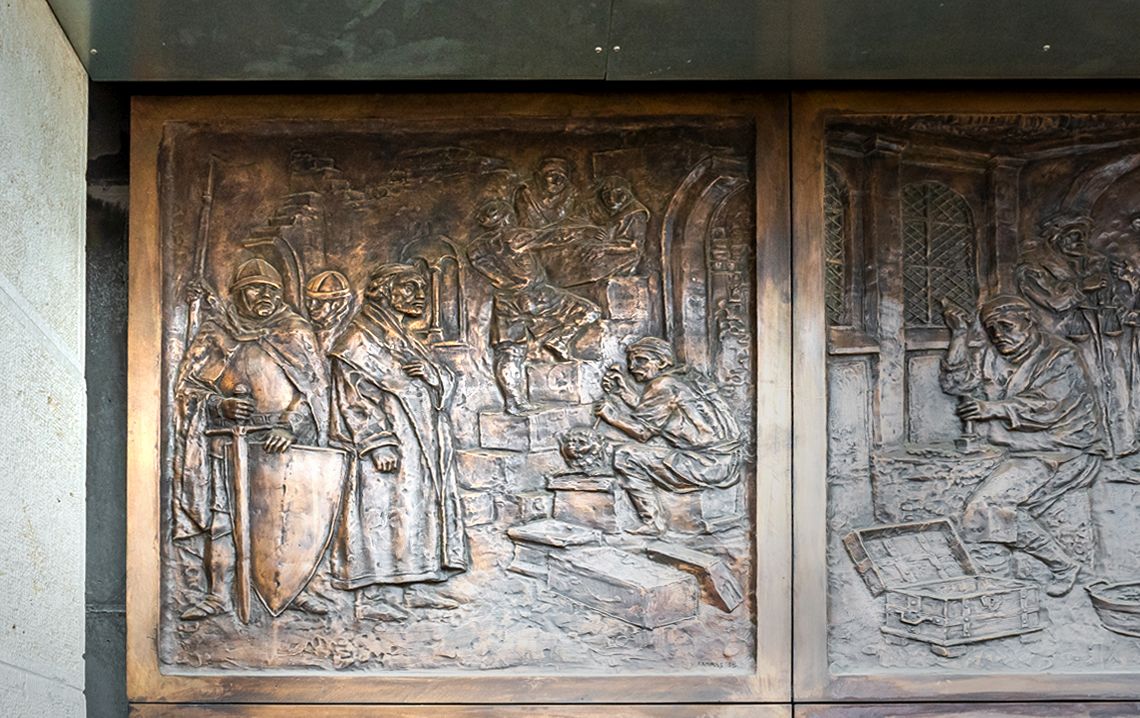
Founder of the city of Buda, Béla IV on the bronze gate in Csikós Courtyard; one of the 27 plaques (Photo: Balázs Both/pestbuda.hu)
It is clear from Pestbuda's article, then, that public artworks contain information, inform, report, communicate, conjecture, and if they carry false messages, counterfeiting is fixed. The figure of Abdurrahman is tamed into a fallen hero soldier, Prince Eugene of Savoy is exalted undeservedly, and the founder of the city, Béla IV, whose traces we walk on to this day, is forgotten.
Yet on the 750th anniversary of his death, our great king would have deserved to have at least one plaque erected for him in the settlement he had created, which had been the capital of the country for centuries and is still the pride of the Hungarians. Maybe someone is interested, in addition to the many, many other sights, in the fact that Béla IV founded the city of Buda.
Cover photo: Statue of Béla IV on the Parliament building (Photo: Balázs Both/pestbuda.hu)

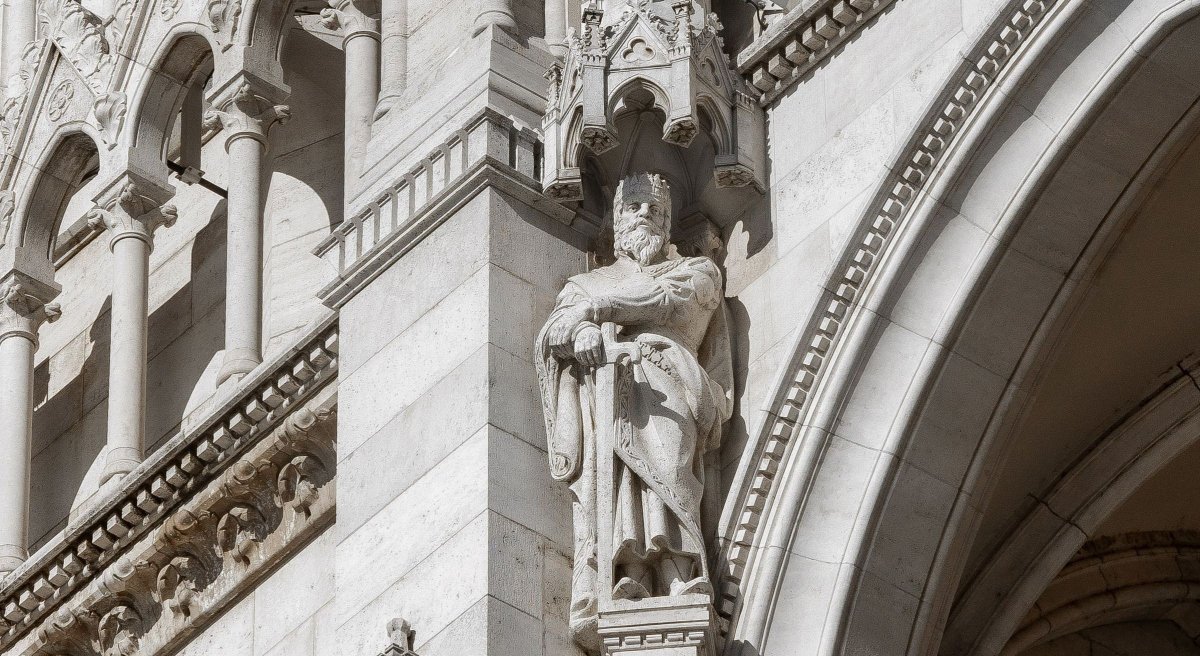
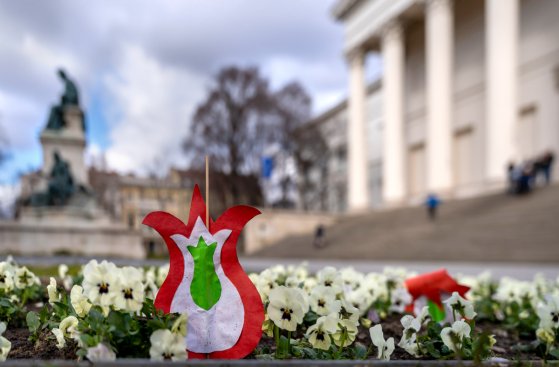
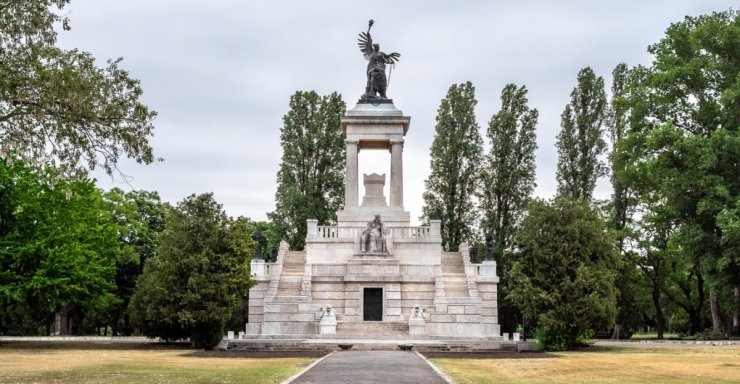

































Hozzászólások
Log in or register to comment!
Login Registration